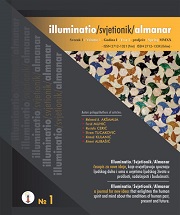Analiza korištenja terminoloških odrednica „umjetnost islama“ i „islamska umjetnost“
An analysis of the use of terminological determinants „art of islam“ and „islamic art“
Author(s): Mehmed A. AkšamijaSubject(s): Islam studies, Sociology of Art, History of Art
Published by: Centar za dijalog - Vesatijja
Keywords: Islamic art; art of Islam; homo islamicus; homo fannān; skill of action/arranging/designing; design; qadar/ṣināʿat; cognitive and precognitive productive-reflective representation;
Summary/Abstract: This paper is a distinctive analysis of the phenomenological value of terms „Islamic art“ or „art of Islam“, which attempts to clarify the common treatment of such terms found in both Western and Muslim sources and which are inappropriate and ungrounded formulations from the viewpoint of traditional Islamic civilizational principles. By focusing on the cognitive and precognitive approach to the productive-reflective representation of elements of visual art within this topic (i.e. by offering a possible solution) this study „comes into conflict“ with stereotypes that contemporary theories and history of art in the spirit of Western understanding of civilization, which can apply the aspect of globalization to anything it considers within the scope of its scientific area and approaches any civilizational achievement in the same way, reducing it to classic Western postulates. In the explanation of this phenomenon (i.e. a prominent rather than appropriate need to reduce all forms of creative activity to common denominators whereby some lose and others win) the study introduces corresponding Latin and Arabic terms in parallel, and their possible lexical connections through theoretical tenets of Western civilizational circle to come closer to distinctive characteristics of Eastern/Islamic civilizational circle (homo faber, homo islamicus, homo fannān, and so forth). It is interesting and totally distinctive that it is by approaching this terminology both from the Eastern and from the opposite, Western side through a methodological process one comes to the conclusion that these are diametrically opposite phenomena, which the ultimate Western definition names „art“, while Islamic denotation is explained and defined by means of terms grounded in the sacral and profane productive-reflective discourse of homo islamicus’s action-design/ qadar, respectively qadar/ṣināʿat. Thus, we will conclude that understanding and the essential meaning of the concept of „art“ in Islamic civilization from the one hand and in other civilizations on the other are not and cannot be the same. Also, many of the issues and dogmas raised earlier are mentioned and some are addressed in this paper.
Journal: Illuminatio/Svjetionik/Almanar
- Issue Year: 1/2020
- Issue No: 1
- Page Range: 40-100
- Page Count: 54
- Language: Bosnian, English

